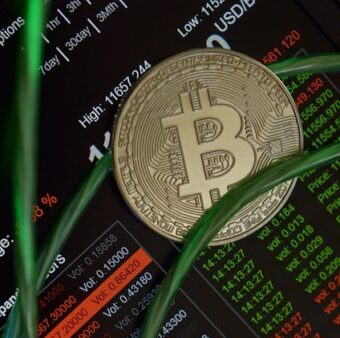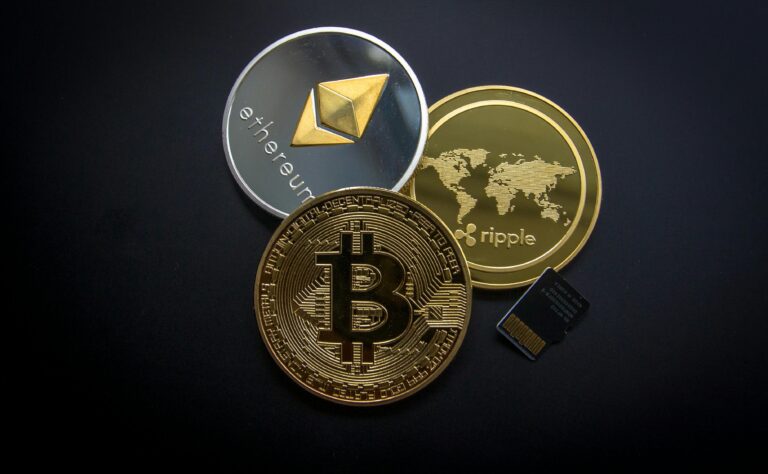How DeFi Works: The Technology Behind Decentralized Finance

Decentralized Finance (DeFi) is revolutionizing the global financial ecosystem by leveraging blockchain technology to create peer-to-peer financial systems that operate without traditional intermediaries.
Image by Miloslav Hamřík from Pixabay.
This comprehensive guide explores the technological foundations, key components, and future potential of DeFi, providing insights into how this innovative approach is reshaping our understanding of financial services and transactions.
Introduction to Decentralized Finance (DeFi)
Decentralized finance, commonly known as DeFi, represents a paradigm shift from conventional centralized financial systems to peer-to-peer finance enabled by decentralized technologies primarily built on blockchain networks. At its core, DeFi aims to create an open, permissionless financial system where individuals, businesses, and other entities can transact directly with each other without relying on intermediaries like banks or financial institutions.
The Core Principles of DeFi
DeFi operates on several fundamental principles that distinguish it from traditional financial systems:
- Decentralization: DeFi removes central authorities and intermediaries from financial transactions, distributing control among network participants rather than concentrating it in the hands of a few institutions.
- Transparency: All transactions on DeFi platforms are recorded on public blockchains, allowing anyone to verify and audit the system’s operation without compromising user privacy.
- Accessibility: DeFi services are open to anyone with an internet connection, regardless of geographic location or socioeconomic status, eliminating the barriers to entry that exist in traditional finance.
- Autonomy: Users maintain full control over their assets and financial activities without needing permission from central authorities.
Blockchain Technology: The Backbone of DeFi
Blockchain serves as the foundational technology that makes DeFi possible. At its essence, blockchain is a distributed and secured database or ledger where financial transactions are recorded in computer code.
Key characteristics of blockchain technology that enable DeFi include:
- Distributed Ledger: All participants using a DeFi application have identical copies of the public ledger, which records every transaction in encrypted code.
- Immutability: Once recorded, information in a blockchain is extremely difficult to alter, providing security against fraudulent activity.
- Transparency: The public nature of blockchains allows for verification of payments and ownership records while maintaining user anonymity through encryption.
- Security Protocols: Blockchains use advanced cryptography and consensus mechanisms to secure transactions and prevent unauthorized access or manipulation.
In a traditional banking system, your transaction history is stored in a private ledger owned and managed by a financial institution. In contrast, blockchain creates a public, decentralized record where transactions are verified by a network of computers rather than a central authority. This fundamental shift in how financial information is stored and verified forms the technological foundation that enables DeFi applications to function securely and transparently.
Smart Contracts: Automating Financial Transactions
Smart contracts are self-executing agreements with the terms directly written into code. They automatically enforce and execute the terms of an agreement when predefined conditions are met, eliminating the need for intermediaries.
In the DeFi ecosystem, smart contracts serve as the essential building blocks that power various financial applications and services. These programmable contracts run on blockchain networks (primarily Ethereum) and execute exactly as programmed, providing several key advantages:
- Automation: Smart contracts automatically execute transactions when conditions are met, reducing the need for manual processing and potential human error.
- Immutability: Once deployed, smart contracts cannot be altered, ensuring that they will always execute according to their original programming.
- Transparency: The code for most DeFi smart contracts is open-source, allowing anyone to audit and verify how they work.
- Trustlessness: Users don’t need to trust each other or a third party; they only need to trust the code itself, which is publicly verifiable.
Smart contracts enable various DeFi applications, from simple token swaps to complex financial instruments like flash loans. For example, in lending protocols like Aave, smart contracts automatically adjust interest rates based on supply and demand, manage collateral, and handle loan distributions without human intervention. Similarly, decentralized exchanges use smart contracts to facilitate peer-to-peer trading of digital assets without centralized custody of funds.
Decentralized Applications (dApps)
Decentralized applications, or dApps, are software programs powered by blockchain technology that provide various services without relying on central authorities or intermediaries. While they may appear similar to traditional applications on the surface, dApps operate on a fundamentally different technological infrastructure.
The key differences between dApps and traditional applications include:
- Blockchain Backend: dApps use blockchain technology instead of conventional databases, recording all transactions and actions on a distributed ledger.
- Cryptocurrency Payments: Users typically pay for dApp services using cryptocurrency, which enables the execution of smart contracts.
- Open Source: dApps are frequently open source, allowing anyone to view, audit, and even contribute to their code.
- Decentralized Operation: Rather than running on centralized servers, dApps operate across decentralized networks of computers.
To use a dApp, users typically connect their cryptocurrency wallets (like MetaMask) to the application. When they perform an action, such as making a trade or providing liquidity, they pay a small amount of cryptocurrency to execute the relevant smart contract. This transaction is then recorded on the blockchain, creating a permanent and transparent record of the activity.
Popular DeFi dApps include decentralized exchanges like Uniswap, lending platforms like Aave and Compound, and stablecoin protocols like MakerDAO. Each of these applications serves a specific financial function while maintaining the core principles of decentralization and user control4.
Key Components of DeFi Ecosystem
The DeFi ecosystem consists of various interconnected components that collectively create a comprehensive alternative to traditional financial services:
Decentralized Exchanges (DEXs)
DEXs allow users to trade cryptocurrencies directly with each other without intermediaries:
- Automated Market Makers (AMMs): Platforms like Uniswap use liquidity pools and mathematical formulas to determine asset prices rather than traditional order books4.
- Order Book DEXs: Some decentralized exchanges maintain limit order books similar to traditional exchanges but without centralized control.
- Liquidity Providers: Users can contribute assets to liquidity pools in exchange for a portion of trading fees, creating a decentralized market-making system.
Lending and Borrowing Platforms
These platforms enable peer-to-peer lending and borrowing of crypto assets:
- Overcollateralized Loans: To mitigate risk, borrowers typically provide collateral exceeding the value of their loan.
- Interest Rate Determination: Interest rates are algorithmically determined based on supply and demand dynamics.
- Flash Loans: Uncollateralized loans that must be borrowed and repaid within a single blockchain transaction, enabling unique arbitrage and liquidation opportunities.
Stablecoins
Stablecoins are cryptocurrencies designed to maintain a stable value, often pegged to fiat currencies like the US dollar:
- Collateralized Stablecoins: Backed by cryptocurrencies (like DAI) or fiat currencies (like USDC).
- Algorithmic Stablecoins: Use algorithms and smart contracts to maintain price stability through automatic supply adjustments.
- Price Stability: Provide a reliable medium of exchange and store of value within the volatile crypto ecosystem.
Yield Farming and Liquidity Pools
These mechanisms allow users to earn returns on their crypto assets:
- Liquidity Mining: Users provide liquidity to protocols and receive governance tokens as rewards.
- Yield Aggregators: Automatically move user funds between different protocols to maximize returns.
- Risk and Reward: Higher yields typically correspond with higher risks, including smart contract vulnerabilities and impermanent loss.
These components function together within the DeFi ecosystem, creating a rich and diverse financial landscape that offers alternatives to traditional banking, trading, and investment services.
Interoperability in DeFi
Interoperability—the ability of different blockchain networks and DeFi protocols to communicate and work together—is becoming increasingly important as the ecosystem grows. This interconnectedness enables the creation of more complex financial services and enhances the overall utility of DeFi applications.
The DeFi ecosystem demonstrates remarkable composability, often described as “money legos,” where different protocols can be combined to create new financial products and services. For example:
- A user might deposit stablecoins into a lending protocol like Aave to earn interest.
- The interest-bearing tokens received can then be used as collateral in another protocol.
- This collateral might enable borrowing of different assets, which can be used for trading on a DEX.
- Any profits can be reinvested into liquidity pools or yield farming strategies.
Cross-chain compatibility is another critical aspect of interoperability, allowing assets and information to flow between different blockchain networks. Technologies such as:
- Blockchain Bridges: These connect different blockchain networks, allowing assets to move between them while maintaining their value and utility.
- Cross-Chain Protocols: These enable communication and interaction between different blockchains, expanding the potential use cases for DeFi applications.
- Wrapped Assets: Tokens that represent assets from one blockchain on another (such as Wrapped Bitcoin on Ethereum), enabling cross-chain utilization of assets.
As the DeFi ecosystem continues to evolve, interoperability will likely play an increasingly important role in creating a more integrated and efficient financial system that transcends the limitations of individual blockchain networks.
Security Considerations in DeFi
While DeFi offers numerous advantages, it also presents unique security challenges that users and developers must address:
Common Vulnerabilities
DeFi platforms face several security risks:
- Smart Contract Vulnerabilities: Coding errors or logical flaws in smart contracts can lead to exploitation and loss of funds.
- Oracle Attacks: Manipulation of price feeds and other external data sources that smart contracts rely on can lead to system exploitation.
- Flash Loan Attacks: Attackers use uncollateralized flash loans to temporarily manipulate market prices and exploit vulnerable protocols.
- Governance Attacks: Accumulation of governance tokens to force malicious protocol changes.
- Rug Pulls: Developers abandoning projects after collecting user funds, particularly common in newer, unaudited projects.
Best Practices for Users
To secure assets in the DeFi ecosystem, users should:
- Research Thoroughly: Investigate protocols, team backgrounds, code audits, and community reputation before investing.
- Start Small: Begin with smaller amounts while learning how different protocols function.
- Use Hardware Wallets: Store majority holdings in cold storage solutions that aren’t constantly connected to the internet.
- Check Smart Contract Audits: Prioritize protocols that have undergone multiple security audits by reputable firms.
- Diversify Holdings: Avoid concentrating assets in a single protocol to reduce exposure to potential vulnerabilities.
- Monitor Protocol Updates: Stay informed about changes to protocols where you’ve allocated assets.
- Be Wary of High Yields: Extremely high returns often indicate higher risks or unsustainable tokenomics.
Despite these precautions, it’s important to recognize that DeFi is still in its infancy and carries inherent risks. Smart contract failures and security breaches remain common challenges in the ecosystem, highlighting the importance of careful risk management and continuous improvement of security practices.
The Role of Governance in DeFi
Decentralized governance is a fundamental aspect of many DeFi projects, allowing community members to collectively determine the future direction of protocols. This approach distributes decision-making power among stakeholders rather than concentrating it with a central team or entity.
How Decentralized Governance Works
DeFi governance typically operates through the following mechanisms:
- Governance Tokens: Special tokens that grant voting rights on protocol decisions, often distributed to users, liquidity providers, and early adopters.
- Proposal Systems: Community members can submit proposals for changes to protocol parameters, fee structures, or new features.
- Voting Processes: Token holders vote on proposals, with voting power typically proportional to the number of tokens held.
- Execution: Approved changes are implemented through smart contracts, often after a time delay to allow users to exit if they disagree with decisions.
- Decentralized Autonomous Organizations (DAOs): Organizational structures governed entirely by token holders and smart contracts, representing the most advanced form of decentralized governance.
Importance of Community Involvement
Community governance provides several benefits to DeFi protocols:
- Alignment of Incentives: When users become stakeholders, their interests align more closely with the long-term success of the protocol.
- Collective Intelligence: Drawing on the diverse expertise and perspectives of community members often leads to better decision-making.
- Resistance to Censorship: Distributed governance makes it more difficult for external entities to censor or shut down protocols.
- Adaptive Development: Protocols can evolve based on user needs and market conditions rather than following a predetermined roadmap.
However, governance systems also face challenges, including voter apathy, concentration of voting power, and the technical complexity of protocol decisions. As DeFi continues to mature, governance mechanisms will likely evolve to address these challenges while maintaining the core principle of community-led decision-making.
Challenges Facing DeFi Technology
Despite its revolutionary potential, DeFi faces several significant challenges that must be addressed for mainstream adoption:
Technical Challenges
- Scalability Issues: Most DeFi applications run on Ethereum, which has faced congestion and high transaction fees during periods of high demand. Layer 2 solutions and Ethereum 2.0 aim to address these issues, but scalability remains a significant hurdle.
- User Experience: DeFi interfaces can be complex and intimidating for newcomers, creating a barrier to adoption. Simplifying user experiences without compromising security is an ongoing challenge.
- Interoperability Limitations: While progress is being made, seamless interaction between different blockchains and protocols remains challenging.
Regulatory Challenges
- Regulatory Uncertainty: The regulatory status of many DeFi activities remains unclear in most jurisdictions, creating uncertainty for developers and users.
- Compliance Requirements: Traditional financial regulations like KYC/AML are difficult to implement in decentralized systems, creating potential legal risks.
- Tax Implications: The tax treatment of complex DeFi transactions like yield farming and liquidity provision is often unclear and varies by jurisdiction.
Security and Risk Challenges
- Smart Contract Risks: As mentioned earlier, the security of smart contracts remains a significant concern, with hacks and exploits occurring regularly in the ecosystem.
- Oracle Dependencies: Many DeFi applications rely on external data sources (oracles), which can introduce vulnerabilities if compromised.
- Market Volatility: The underlying volatility of cryptocurrencies creates risk for users, particularly in lending and borrowing applications.
Adoption Challenges
- Education Gap: Understanding DeFi requires knowledge of both traditional finance and blockchain technology, creating a steep learning curve for potential users.
- Trust Issues: High-profile hacks and scams have damaged trust in the DeFi ecosystem, making some potential users hesitant to participate.
- Infrastructure Limitations: Reliable access to crypto on-ramps, stable internet connections, and computing devices remains limited in many parts of the world.
Addressing these challenges will require collaborative efforts from developers, users, regulators, and other stakeholders in the blockchain and financial sectors.
The Future of DeFi: Innovations on the Horizon
The DeFi landscape continues to evolve rapidly, with several emerging trends and technologies poised to shape its future:
Layer 2 Scaling Solutions
As blockchain networks like Ethereum face scalability challenges, layer 2 solutions are emerging to increase transaction throughput and reduce fees:
- Rollups: Technologies that process transactions off the main blockchain but post transaction data back to it, maintaining security while improving scalability.
- State Channels: Allow participants to conduct multiple transactions off-chain before settling the final state on the blockchain.
- Sidechains: Separate blockchains that run parallel to the main chain, with their own consensus mechanisms and validators.
Cross-Chain DeFi
Innovations enabling seamless interaction between different blockchain networks will expand DeFi’s capabilities:
- Improved Blockchain Bridges: More efficient and secure methods for transferring assets between blockchains.
- Multi-Chain Applications: DeFi protocols designed from the ground up to operate across multiple blockchains.
- Chain-Agnostic Tools: User interfaces and wallets that abstract away blockchain complexity, allowing users to access services across networks seamlessly.
Real-World Asset Tokenization
The integration of traditional assets into DeFi represents a significant frontier:
- Tokenized Securities: Bringing stocks, bonds, and other securities onto blockchains as tokenized assets.
- Real Estate Tokenization: Fractionalizing property ownership through blockchain tokens, enabling more liquid real estate markets.
- Tokenized Commodities: Representing physical assets like gold, oil, or agricultural products as on-chain tokens that can be used in DeFi protocols.
Institutional DeFi
As regulatory clarity improves, institutional participation in DeFi is likely to increase:
- Compliant DeFi Protocols: Services that integrate regulatory requirements while maintaining decentralization where possible.
- Institutional-Grade Infrastructure: More robust security, custody solutions, and risk management tools designed for institutional users.
- Hybrid Finance (HyFi): Systems that bridge traditional finance and DeFi, allowing institutions to gradually adopt decentralized technologies.
Privacy Innovations
Balancing transparency with privacy needs will be crucial for DeFi’s evolution:
- Zero-Knowledge Proofs: Cryptographic methods that allow verification without revealing underlying information.
- Privacy-Preserving Protocols: DeFi services that protect user privacy while maintaining regulatory compliance.
- Confidential Transactions: Methods to shield transaction details while enabling verification of their validity.
These innovations, alongside continued improvements in user experience and security, suggest a promising future for DeFi as it matures and integrates more deeply with the broader financial system.
Conclusion
Decentralized Finance represents a fundamental reimagining of financial services, leveraging blockchain technology, smart contracts, and decentralized applications to create an open, transparent, and accessible financial ecosystem. By removing intermediaries and automating processes through code, DeFi offers unprecedented opportunities for financial inclusion, innovation, and efficiency.
Citations:
- https://www.investopedia.com/decentralized-finance-defi-5113835
- https://consensys.io/blockchain-use-cases/decentralized-finance
- https://www.forbes.com/advisor/investing/cryptocurrency/defi-decentralized-finance/
- https://en.wikipedia.org/wiki/Decentralized_finance
- https://www.bankrate.com/investing/what-are-dapps-cryptocurrency/
- https://www.linkedin.com/pulse/defi-ecosystem-overview-its-structure-functionality
- https://www.financemagnates.com/cryptocurrency/education-centre/the-interoperability-challenge-of-defi-cross-chain-solutions-and-standards/
- https://blog.chain.link/defi-security-best-practices/
- https://coinbound.io/crypto-keywords/
- https://www.ranktracker.com/blog/unlocking-potential-for-substantial-gains-through-seo-in-decentralized-finance/
- https://www.upwork.com/services/product/writing-translation-top-quality-blockchain-and-crypto-seo-articles-1800522125758888277
- https://academic.oup.com/jfr/article/6/2/172/5913239
- https://www.upwork.com/services/product/writing-translation-an-seo-friendly-blog-post-on-crypto-and-web3-1833815802269415240
- https://gov.capital/defi-seo/
- https://www.upwork.com/en-gb/services/product/writing-translation-an-seo-optimized-cryptocurrency-blog-post-for-your-crypto-website-1625945619945234432


4 Comments